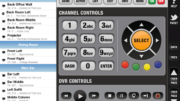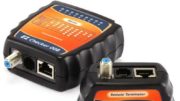If you’re a longtime installer, your experience may be working against you. Any installer worth his (or her) salt knows that long cables mean high loss. A 250 foot run of RG6 is going to give you about 30dB of loss at 2150MHz, which is the high end of the satellite spectrum Even at 550MHz where the connected home signal is found, you are looking at about 13dB of loss. That can be the difference between good signal and no signal. Remember in a Genie installation that the connected home signal is more important than any other signal because it’s used to supply video to the clients.
How long should cable runs be?
Your experience may tell you that if the signal is -25dBm coming out of the SWM — and it should be — that you can run well in excess of 250 feet because we’ve all seen cases where receivers can still display a good signal with signals lower than -55dBm. The audio and video signal is actually very robust and works at ridiculously low levels.
However, there are two things you may not be considering. First of all, never underestimate the effects of a sunny day. You may get great results when doing the install and then you leave and the customer complains of 775 errors on the first rainy day. You can’t control rain fade, but by using the shortest possible cable you can keep signals strong when they reach the receiver.
Second, the connected home signal that is used for Genie clients at 550MHz is not as robust as the audio/video signal. (this same signal is used for whole-home sharing in older installs.) Although you have less loss at that frequency, it can have a greater effect. If you start with -25dBm and split out to an 8-way, losing another 14dB, then lose another 13dB over a 250′ run, that puts you at -52dBm which is below the recommended -45dBm threshold for connected home communication.
This is a big deal…
…and it’s something many installers don’t test other than looking for the green light on the client. It doesn’t matter if the Genie gets great signal if the clients are receiving it. Make sure before you leave the premises that you run a connected home test using your AIM meter at every location where there is a wired client. It’s a little harder to get really detailed information on the wireless clients. The good news there is they test themselves pretty intensively when you install them.
Can you use an amplifier?
No, unfortunately. Making matters worse, none of the commercial amps amplify that 550MHz signal effectively. Non-satellite amps can amplify that frequency. However, these tend to be OTA antenna amps and can introduce a lot of noise into the satellite signal. More importantly they aren’t bidirectional and so they really won’t solve the problem.
The bottom line is that you can amplify in order to get more audio/video, but there’s no amp that will give you more range out of MRV. Remember, it’s not just a matter of one-way amplification like a satellite signal; the MRV signal needs to be amplified going both directions.
It’s a good idea to use a cable calculator like this one, and plan your runs to make sure you avoid long runs and large splitters. For long runs, RG11 cable is a decent choice. Really it’s better to use a legacy dish and an external multiswitch. There’s a lot more copper involved but by putting the SWM where you need it, you can maximize signal strength. . If this is a multi-dwelling unit install you may be able to do a single run to a neutral location. Then you can put the splitter closer to the individual residences. Just remember to use a band stop filter to keep the connected home signal from traveling unnecessarily.





